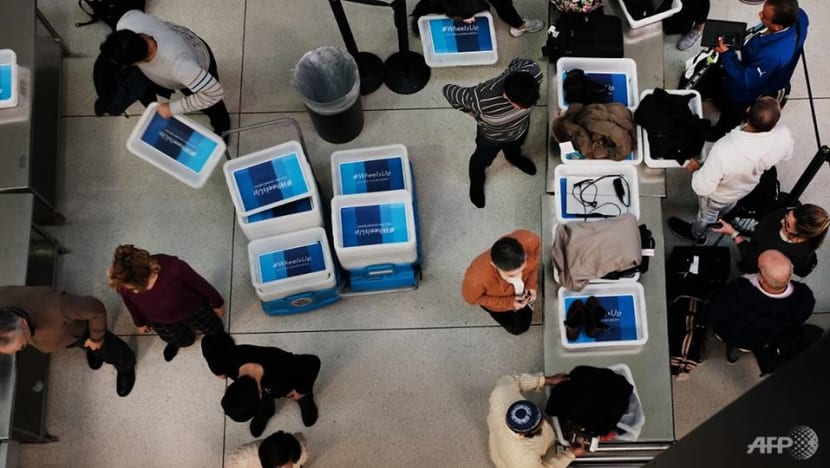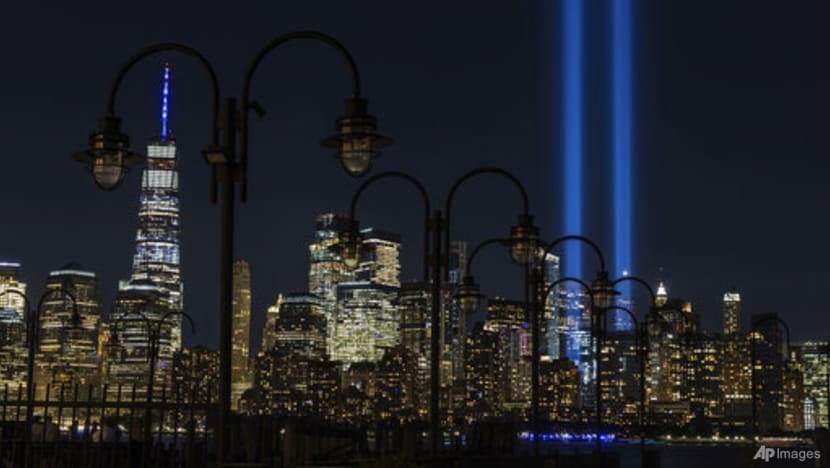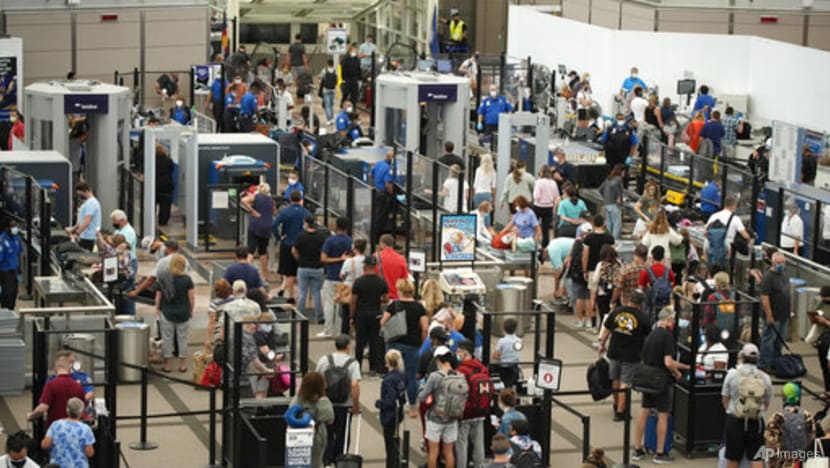Commentary: Air travel used to be easy. Then 9/11 happened
Passengers might see the eventual end of COVID-19 public health measures in airports, but a return to pre-9/11 security levels is unlikely, says an aviation historian.

Passengers wait in a Transportation Security Administration line at JFK airport on in New York City. (Photo: AFP / SPENCER PLATT)
DAYTON, Ohio: During the mid-1990s, I travelled between Dayton, Ohio, and Washington DC, twice a month during the school year as half of a commuting couple.
I could leave Dayton by 5.15pm, drive nearly 120km to the Columbus airport during rush hour, park my car in the economy lot, and still get to my gate in plenty of time for a 7.30pm departure.
Then 9/11 happened.
The terrorist attacks brought swift and lasting changes to the air travel experience in the United States.
And after 20 years of ever more elaborate airport security protocols, many air travellers have no knowledge of - or only vague memories of - what air travel was like before 9/11.
As someone old enough to remember air travel before 9/11 - I find it striking, on the one hand, how reluctant the federal government, the airlines, and airports were to adopt early security measures.
On the other hand, it has been jarring to watch how abruptly the sprawling US Transportation Security Agency (TSA) system was created and how quickly American air travellers came to accept those security measures as both normal and seemingly permanent features of all US airports.
SECURITY WITHOUT INCONVENIENCE
In the early decades of air travel, airport security, beyond basic policing, was essentially nonexistent. Getting on a plane was no different from getting on a bus or train.

But in the late 1960s and early 1970s, there was a wave of hijackings, terrorist attacks and extortion attempts - the most infamous being that of the man known as DB Cooper, who commandeered a Boeing 727, demanded US$200,000 and upon securing the case, dramatically parachuted from the plane, never to be found.
Attacks on US flights usually prompted another new security measure, whether it was the formation of the air marshal programme, which placed armed federal agents on US commercial aircraft; the development of a hijacker profile, aimed at identifying people deemed likely to threaten an aircraft; or the screening of all passengers.
By 1973, under the new protocols, air travellers had to pass through a metal detector and have any bags X-rayed to check for weapons or suspicious objects.
For the most part, however, these measures were intended to reassure nervous flyers, security theatre that sought to minimally impede easy passage from check-in to gate.
For domestic travel, it was possible to arrive at the airport terminal 20 to 30 minutes before your flight and still be able to reach the gate in time to board. Families and friends could easily accompany a traveller to their gate for take-off and meet them at the gate upon their return.
Above all, airlines did not want to inconvenience passengers, and airports were reluctant to lose the extra revenue from family and friends who might frequent airport restaurants, bars and shops when dropping off or picking up those passengers.
In addition, these security measures, though called for by the Federal Aviation Administration, were the responsibility of not the federal government, but the airlines. And to keep costs down, the airlines tended to contract private companies to conduct security screenings that used minimally trained low-paid employees.
A SERIES OF NEW MEASURES
All that changed with the 9/11 terrorist attacks.
Once the airlines returned to the skies on Sep 14, 2001, it was immediately apparent that flying was going to be different. Passengers arriving at airports were greeted by armed military personnel, as governors throughout the country had mobilized the National Guard to protect the nation’s airports. They remained on patrol for several months.
Security measures only increased in December 2001, when Richard Reid, the so-called “Shoe Bomber,” attempted to set off explosives in his shoes on an international flight from Paris to Miami. Taking off your shoes before passing through security quickly became a requirement.
Then, in 2006, British officials intercepted an attempt to carry liquid explosives aboard a flight, resulting in a ban on all liquids. This was later modified to restricting passengers to liquids of no more than 100ml. By 2010, the full body scanner had become a familiar sight at airports throughout the US.
A 2019 study indicated that the average time to get through security at some of the nation’s busiest airports varied from just over 23 minutes at New Jersey Newark Liberty to 16.3 minutes at Seattle-Tacoma but could go as high as 60 minutes and 34 minutes, respectively, at those same two airports during peak times.

These new security measures became the responsibility of the federal government to enforce. In November 2001, US Congress created the US TSA, and by the early months of 2002, their employees had become the face of transportation security throughout the US, at airports as well as railroads, subways and other forms of transportation.
Today, the TSA employs over 50,000 agents.
THE NEW NORMAL OF AIR TRAVEL
In the first decade after 9/11, the federal government spent over US$62 billion on airport security in total, as annual spending for the TSA increased from US$4.34 billion in 2002 to US$7.23 billion in 2011 and has only grown since then.
In many ways, the post-9/11 scramble by airport officials to address security concerns was similar to the impulse to address public health concerns in the wake of the COVID-19 pandemic, when plastic barriers, hand sanitisers and floor markings encouraging social distancing appeared at airports throughout the US.
How long the COVID-19 measures will need to stay in place remains to be seen. However, the security measures adopted after 9/11 have proved permanent enough that they have become incorporated into recent airport terminal renovations.
What will be left of airports, airlines and the aviation industry once the COVID-19 storm has calmed? Experts weigh in on Heart of the Matter:
For example, when Reagan National Airport’s new terminal opened in 1997, passengers could move freely between the shop- and restaurant-filled National Hall and the gates in Terminals B and C. After 9/11, airport officials placed security checkpoints at the entrances to Terminals B and C, effectively making shops and restaurants no longer accessible to passengers who had passed through security.
Now, the almost-completed US$1 billion redesign will move the security checkpoints to a new building constructed above the airport’s roadway and open up access among National Hall, Terminals B and C and a new commuter terminal.
Nearly a generation has passed since the terrorist attacks of 9/11. Even those of us old enough to remember air travel before that fateful date have grown accustomed to the new normal.
And while passengers today might quite happily mark the eventual end of the COVID-19 public health security measures, they are far less likely to see a return to pre-9/11 security levels at the airport anytime soon.
Janet Bednarek is Professor of History at the University of Dayton. The commentary first appeared on The Conversation.














